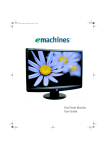Download eMachines Flat Panel Monitor User guide
Transcript
Flat Panel Monitor User Guide Contents Using Your eMachines Flat-Panel Monitor . . . . . . . . . . . . . . . . . . . . . . . . . . . 1 Unpacking the monitor . . . . . . . . . . . . . . . . . . . . . . . . . . . . . . . . . . . . . . . . . . . . . . . . . . . . . 2 Connecting the monitor . . . . . . . . . . . . . . . . . . . . . . . . . . . . . . . . . . . . . . . . . . . . . . . . . . . . 3 Attaching the base . . . . . . . . . . . . . . . . . . . . . . . . . . . . . . . . . . . . . . . . . . . . . . . . . . 3 Connecting video inputs . . . . . . . . . . . . . . . . . . . . . . . . . . . . . . . . . . . . . . . . . . . . . 4 Connecting power . . . . . . . . . . . . . . . . . . . . . . . . . . . . . . . . . . . . . . . . . . . . . . . . . . . 5 Connecting a security cable . . . . . . . . . . . . . . . . . . . . . . . . . . . . . . . . . . . . . . . . . . 5 Setting up the optional stand . . . . . . . . . . . . . . . . . . . . . . . . . . . . . . . . . . . . . . . . . . . . . . . 6 Attaching the USB stand . . . . . . . . . . . . . . . . . . . . . . . . . . . . . . . . . . . . . . . . . . . . . 6 Adjusting monitor height tension . . . . . . . . . . . . . . . . . . . . . . . . . . . . . . . . . . . . . 8 Adjusting monitor tilt tension . . . . . . . . . . . . . . . . . . . . . . . . . . . . . . . . . . . . . . . . 9 Connecting the USB hub . . . . . . . . . . . . . . . . . . . . . . . . . . . . . . . . . . . . . . . . . . . . 10 Setting up the optional speaker bar . . . . . . . . . . . . . . . . . . . . . . . . . . . . . . . . . . . . . . . . 11 Installing the speaker bar . . . . . . . . . . . . . . . . . . . . . . . . . . . . . . . . . . . . . . . . . . . 11 Starting the monitor . . . . . . . . . . . . . . . . . . . . . . . . . . . . . . . . . . . . . . . . . . . . . . . . . . . . . . 12 Adjusting monitor settings . . . . . . . . . . . . . . . . . . . . . . . . . . . . . . . . . . . . . . . . . . . . . . . . . 13 Monitor buttons . . . . . . . . . . . . . . . . . . . . . . . . . . . . . . . . . . . . . . . . . . . . . . . . . . . 13 On-screen display options . . . . . . . . . . . . . . . . . . . . . . . . . . . . . . . . . . . . . . . . . . 14 Changing Windows screen settings . . . . . . . . . . . . . . . . . . . . . . . . . . . . . . . . . . 17 Video modes . . . . . . . . . . . . . . . . . . . . . . . . . . . . . . . . . . . . . . . . . . . . . . . . . . . . . . . 18 Power management . . . . . . . . . . . . . . . . . . . . . . . . . . . . . . . . . . . . . . . . . . . . . . . . . . . . . . 19 ENERGY STAR . . . . . . . . . . . . . . . . . . . . . . . . . . . . . . . . . . . . . . . . . . . . . . . . . . . . . . 19 Energy declaration . . . . . . . . . . . . . . . . . . . . . . . . . . . . . . . . . . . . . . . . . . . . . . . . . 19 Maintaining . . . . . . . . . . . . . . . . . . . . . . . . . . . . . . . . . . . . . . . . . . . . . . . . . . . . . . . . . . . . . . 20 Troubleshooting . . . . . . . . . . . . . . . . . . . . . . . . . . . . . . . . . . . . . . . . . . . . . . . . . . . . . . . . . . 20 No power . . . . . . . . . . . . . . . . . . . . . . . . . . . . . . . . . . . . . . . . . . . . . . . . . . . . . . . . . 20 No picture . . . . . . . . . . . . . . . . . . . . . . . . . . . . . . . . . . . . . . . . . . . . . . . . . . . . . . . . . 20 Display colors are wrong . . . . . . . . . . . . . . . . . . . . . . . . . . . . . . . . . . . . . . . . . . . 21 Picture has shadows or “ghosts” . . . . . . . . . . . . . . . . . . . . . . . . . . . . . . . . . . . . . 21 Color is not uniform . . . . . . . . . . . . . . . . . . . . . . . . . . . . . . . . . . . . . . . . . . . . . . . . 21 Image is not sized or centered correctly . . . . . . . . . . . . . . . . . . . . . . . . . . . . . . 21 The monitor has pixels that are always dark or too bright . . . . . . . . . . . . . 22 Connecting an HDMI source (19-inch model) . . . . . . . . . . . . . . . . . . . . . . . . . . 22 Connecting a game console . . . . . . . . . . . . . . . . . . . . . . . . . . . . . . . . . . . . . . . . . 22 Speaker bar does not work . . . . . . . . . . . . . . . . . . . . . . . . . . . . . . . . . . . . . . . . . 22 Specifications . . . . . . . . . . . . . . . . . . . . . . . . . . . . . . . . . . . . . . . . . . . . . . . . . . . . . . . . . . . . . 24 Safety, Regulatory, and Legal Notices . . . . . . . . . . . . . . . . . . . . . . . . . . . . . . 25 Recycling . . . . . . . . . . . . . . . . . . . . . . . . . . . . . . . . . . . . . . . . . . . . . . . . . . . . . . . . . . 27 i Contents ii Using Your eMachines Flat-Panel Monitor • • • • • • • • • Connecting the monitor Setting up the optional stand Setting up the optional speaker bar Starting the monitor Adjusting monitor settings Power management Maintaining Troubleshooting Specifications 1 Using Your eMachines Flat-Panel Monitor Unpacking the monitor Your monitor box should contain the following items: • Monitor (with neck attached) • Base • This User Guide • VGA cable • Power cord If you are missing any items, call Customer Care. For telephone numbers, see the label on the back of your monitor. 2 www.emachines.com Connecting the monitor Important To attach the optional USB stand instead of the base, complete the instructions in “Setting up the optional stand” on page 6. To set up the monitor, first attach the base, then make your cable connections. Attaching the base To attach the base: • Place the monitor base on a table top, then slide the monitor neck down onto the base until it clicks into place. You may need to press the two buttons on the base to let the monitor slide on smoothly. Base buttons 3 Using Your eMachines Flat-Panel Monitor Connecting video inputs To connect video sources to your monitor: 1 Position your computer and the monitor so you can reach the back of each. Tip (19-inch model) When using the optional speaker bar (described in “Setting up the optional speaker bar” on page 11), we recommend that you use the included right-angle VGA cable for the video connection so the speaker bar does not obstruct the cable. In the United States, if you are using a DVI connection, you can order a right-angle DVI cable from www.gateway.com. 2 If your computer has a digital video connector (DVI), connect a DVI video cable (not included) to the white connector under the back of the display. The DVI jack is only available on the 19-inch model. In the United States, you can buy a DVI video cable from www.gateway.com. - OR Connect the blue VGA video cable to the blue VGA video connector under the back of the display. (The appearance of your cable and connector may vary from that shown.) 3 Make sure that your computer is turned off, then connect the other end of the video cable to the matching video port on the back of your computer. 4 www.emachines.com Connecting power To connect power: 1 Position your monitor so you can reach the back, then connect the power cord to the power connector under the back of the monitor. (The appearance of your cable and connector may vary from that shown.) 2 Plug the power cord into a correctly grounded power outlet. We recommend using a surge protector to protect your monitor from voltage spikes. Connecting a security cable You can secure your monitor to your computer desk (or to another heavy object) with a cable lock (such as a Kensington™ lock). To connect a cable lock, follow the cable lock’s instructions to connect it to the lock slot on the back of your monitor (cable lock not included). Cable lock slot 5 Using Your eMachines Flat-Panel Monitor Setting up the optional stand Attaching the USB stand In the United States, you can buy an adjustable USB stand from www.gateway.com. You can adjust the stand for height, tilt, and screen rotation. When the stand is connected to your computer’s USB port, you can connect up to four USB devices to the USB 2.0 ports on the stand. To attach the adjustable stand: 1 Make sure that the monitor is turned off. 2 Place the monitor face-down on a stable, soft (non-marring) surface. A non-slip mat on a tabletop is ideal. Let the monitor base hang down over the edge of the table. 3 Remove the screw from the neck hinge, then remove the neck from the LCD panel. Screw 4 Remove the four small screws from the back of the LCD panel. Save the four screws. Screw Screw Screw Screw 5 Slide the adjustable stand’s neck onto the base. 6 www.emachines.com 6 Tighten the thumbscrew under the base with your fingers (or a flat screwdriver) to secure the neck into place. Thumbscrew 7 With the stand facing you, press the mounting bracket lever to the left and hold it, then remove the bracket from the stand. 8 Attach the bracket to the LCD panel using the four screws you removed previously. Screws Screws 7 Using Your eMachines Flat-Panel Monitor 9 Slide the neck’s bracket slot onto the bracket’s mounting tab. 10 Press the bracket lever to the right and hold it, then lower the neck into place and release the lever. Adjusting monitor height tension The stand is factory adjusted to maintain the height for your monitor. However, if it does not stay in place when you let go, you need to change the stand’s height tension. You also need to adjust the stand if the amounts of force required to raise and lower the monitor are not equal. To adjust your monitor’s height tension: 1 Press the screwdriver access hole cap from below the base to remove it from the base. Screwdriver access cap 8 www.emachines.com 2 Insert a Phillips screwdriver through the access hole in the base and onto the height tension screw (on the back of the stand, in the slot above the USB In port). Height tension screw 3 Adjust the height tension screw so the monitor stays in place when you let go. If the monitor lowers by itself when you let go, turn the screw clockwise several complete turns. If the monitor rises when you let go, turn the screw counter-clockwise several complete turns. You may need to turn the screw several times before the tension is correct for your size of monitor. 4 Adjust the height tension screw so the raising and lowering forces are equal. After the forces are equalized, turn the tension screw clockwise two to four turns to slightly decrease the lifting tension. 5 Replace the screwdriver access hole cap. 6 For optimum viewing, adjust the height so the top of the monitor is about 1 inch (2.5 cm) below eye level. Adjusting monitor tilt tension To adjust your monitor’s tilt tension: • Adjust the tilt tension screw (on the top of the stand) so the monitor stays in place when you let go. If the monitor changes its tilt angle when you let go, turn the screw clockwise one complete turn to increase the tension. Tilt tension screw 9 Using Your eMachines Flat-Panel Monitor Ergonomic guidelines The recommended screen positioning is based upon the following guidelines. These guidelines are based on available scientific literature and published standards. Screen height The recommended screen height for displays (except in special circumstances, such as for bifocal use) is that the top of the display should be set at or slightly below (about 1 inch or 25 mm) your eye level while you are sitting in a comfortable working posture. This guideline places the center of the screen at an ideal 15° to 20° viewing angle for most desktop displays. If the display has multiple users, the screen height should be easily adjustable to accommodate each user’s height and preference. Screen tilt The screen should be tilted so your line of sight is perpendicular to the screen. This angle creates the most consistent viewing distance when scanning from the top of the screen to the bottom. You may need to adjust lighting to avoid screen glare when the screen is tilted upward. Screen distance from user The screen should first be placed at arm’s length from the user, then adjusted back and forth to suit individual preference. Connecting the USB hub The optional USB stand has a built-in, 4-port, USB 2.0 hub. To use these USB ports, you need to connect the hub to a power outlet and to your computer. To connect your USB stand’s built-in USB hub: 1 Plug the included USB cable into the USB In port on the back of your USB stand and into a USB 2.0 port on your computer. If you connect the stand to a USB 1.1 port on your computer, the stand’s USB hub operates in USB 1.1 mode (much slower than USB 2.0). USB In port Power connector USB 2.0 ports 2 To provide full power to your stand’s USB ports (recommended), connect the AC power adapter to the power connector on the back of your USB stand and to an AC power outlet. 10 www.emachines.com Setting up the optional speaker bar Power/Volume control Kensington lock slot Power indicator Headphone jack Bass port (for bass sound. Do not block.) Microphone jack Headphone jack Bass port (for bass sound. Do not block.) Installing the speaker bar To install the speaker bar: Tip (19-inch model) When using the optional speaker bar, we recommend that you use the included right-angle VGA cable for the video connection so the speaker bar does not obstruct the cable. In the United States, if you are using a DVI connection, you can order a right-angle DVI cable from www.gateway.com. 1 Tilt the screen back, then center the speaker bar below the screen. Make sure that the speakers face forward. 2 Tighten the two thumbscrews on the back of the speaker bar. 3 Connect the speaker bar’s USB power cord to any available USB port on your computer. 4 Connect the speaker bar’s headphone (green) and microphone (pink) cables to your computer’s headphone and microphone jacks. 5 If your computer is not already on, turn it on. 11 Using Your eMachines Flat-Panel Monitor 6 Turn on the speaker bar by rotating the power/volume knob clockwise. The green LED to the left of the power button is lit when power has been correctly connected and the speaker bar has been turned on. Starting the monitor To start the monitor: 1 Press the power button on the front of your monitor. The power LED on the power button turns on. (The appearance of your monitor may vary from that shown.) Power button 2 Turn on your computer. After your computer is running, the power LED on the monitor’s power button should be blue. Allow about 10 seconds for the display image to appear. If the power LED is not blue or you do not see a display image, check the connections. For more troubleshooting information, see “Troubleshooting” on page 20. 3 Adjust the tilt of the monitor for the best viewing angle. 4 After you see the Windows desktop, press the Auto button on the right side of the monitor to automatically adjust your display image to the ideal settings. 5 Use the on-screen display (OSD) to adjust other monitor settings. For more information, see “Adjusting monitor settings” on page 13. Important When adjusting the monitor settings, always press the Auto button before entering the OSD. This will automatically adjust the display image to the ideal settings for the current screen resolution. 12 www.emachines.com Adjusting monitor settings Use the monitor controls (located on the monitor itself) and computer controls (accessible through Windows) to adjust the display image. For more information about computer controls, see “Changing Windows screen settings” on page 17. Monitor buttons This monitor features an on-screen display (OSD) that lets you adjust contrast, brightness, and other settings for the monitor. The monitor saves changes you make to the settings, even if you turn off the monitor. (The appearance of your monitor may vary from that shown.) Input button Auto button Brightness button Contrast button Menu button • Input • • • • OSD active: Press to move to the previous menu. OSD inactive: Press to select the video source. Auto OSD active: Press to open a menu or setting. OSD inactive: Press to automatically optimize the monitor’s image position, clock, and phase. / (brightness) OSD active: Press to move up through menus and adjust OSD options. OSD inactive: Press to open the Brightness menu. / (contrast) OSD active: Press to move down through menus and adjust OSD options. OSD inactive: Press to adjust the contrast. Menu Press to open or close the OSD. 13 Using Your eMachines Flat-Panel Monitor On-screen display options Adjusting OSD settings To adjust the OSD settings: Tip While the OSD is active, on-screen labels appear next to the buttons to help you identify them. 1 Press the Auto button. The display image is automatically adjusted to the ideal settings for your current screen resolution. 2 Press the Menu button. The OSD opens. 3 Press the / (brightness) or / (contrast) buttons to highlight a setting, then press the Auto button to open the selected menu or setting. 4 Press the / (brightness) or level or change the option. / (contrast) buttons to adjust the setting to the desired 5 Press the Input button to return to a previous menu. 6 When you have finished making all adjustments, press the Menu button at the Main Menu to exit. 14 www.emachines.com OSD menus OSD Menu Description Main menu Main Menu Auto Auto—Automatically adjusts your monitor to its optimum settings. Picture—Opens the Picture menu, where you can adjust brightness, contrast, and gamma. Geometry—Opens the Geometry menu, where you can adjust image size and minimize distortions. Advanced—Opens the Advanced menu, where you can adjust color balance, change the OSD language, and display information about current monitor settings. Reset—Resets the monitor to its factory settings. Picture Geometry Advanced Reset Picture menu Picture Brightness Brightness—Adjusts the amount of light in the darkest portion of the picture. Use the lowest brightness setting you are comfortable with to maximize the life of the monitor backlights. You may need to readjust brightness after the monitor warms up. Contrast—Adjusts the level of white between the lightest and darkest portions of an image. Gamma—Customizes the gamma level. High gamma levels increase white levels and low gamma levels increase contrast. Contrast Gamma 15 Using Your eMachines Flat-Panel Monitor OSD Menu Description Geometry menu Geometry H-Position V-Position H-Position—Moves the display image left and right. You can also press the Auto button to configure the horizontal position automatically. V-Position—Moves the display image up and down. You can also press the Auto button to configure the vertical position automatically. Clock—Minimizes any vertical bars or stripes visible on the screen background. The horizontal screen size will also change. Phase—Minimizes any horizontal distortion and clears or sharpens the displayed characters. Clock Phase Advanced menu Advanced Color Language LED Brightness Resolution Reminder Information 16 Color—Customizes the color levels. Language—Changes the language of the OSD. LED Brightness—Changes the brightness of the Standby and Power LED to Day Mode or Nite Mode. Resolution Reminder—If the computer display input is not set to 1440 × 900, displays a reminder that you should change your computer’s settings to use the optimum 1440 × 900 resolution. If you prefer using your monitor at a resolution less than that, use this option to turn off the Resolution Reminder. For information on changing your computer’s display resolution, see “Changing Windows screen settings” on page 17. Information—Displays the current screen resolution. www.emachines.com Changing Windows screen settings Color depth and screen resolution are two of the most basic monitor settings you may need to change to suit your needs. Color depth is the number of colors your computer uses to display images on your monitor. Most images look best displayed with the maximum number of colors available. If the color in your images seems “false” or “jumpy,” especially after you have played a game or run a video-intensive program, check the color depth setting and return it to the highest color setting, if necessary. Screen resolution is the number of pixels (individual colored dots) your computer uses to display images on your monitor. The higher the resolution, the more information and screen components (such as icons and menu bars) can be displayed on the monitor. Help For more information about adjusting the screen, click Start, then click Help and Support. Type adjusting monitor settings in the Search Help box, then press ENTER. To change the color depth and screen resolution in Windows Vista®: 1 Click (Start), Control Panel, then under Appearance and Personalization, click Adjust Screen Resolution. The Display Settings dialog box opens. Shortcut You can also right-click on your Windows desktop, then click Personalize. 2 To change the color depth, click the Colors list, then click the color depth you want. Color depth settings: • Low (8-bit) = 256 colors • Medium (16-bit) = 65,500 colors • Highest (32-bit) = 16,700,000 colors 3 To change the screen resolution, drag the Resolution slider to the size you prefer. 4 Click Apply. If the new settings do not look right, click No. If the new settings make the screen illegible and you cannot click No, the settings return to their previous values after several seconds. 5 Click OK, then click Yes to save your changes. To change the color depth and screen resolution in Windows XP: 1 Click Start, then click Control Panel. The Control Panel opens. If your Control Panel is in Category View, click Appearance and Themes. Shortcut You can also right-click on your Windows desktop, then click Properties. 2 Click Display. The Display Properties dialog box opens. 3 Click the Settings tab. 4 To change the color depth, click the arrow button to open the Color quality list, then click the color depth you want. Color quality settings: • Low (8-bit) = 256 colors • Medium (16-bit) = 65,500 colors • Highest (32-bit) = 16,700,000 colors 5 To change the screen resolution, drag the Screen resolution slider to the size you prefer, then click OK. The optimum resolution for your display is 1440 × 900. 17 Using Your eMachines Flat-Panel Monitor Video modes Your monitor supports several video modes. If you do not use the best mode for the monitor, the display image may look slightly “fuzzy.” 18 Mode Mode name and resolution Horizontal frequency (kHz) Vertical frequency (Hz) Available in DVI mode (19-inch model) 1 VGA 640 × 350 31.469 70.087 No 2 VGA 640 × 480 31.469 59.941 Yes 3 VESA 640 × 480 37.861 72.810 Yes 4 VESA 640 × 480 37.500 75.000 Yes 5 VGA 720 × 400 31.469 70.087 No 6 VESA 800 × 600 35.156 56.250 Yes 7 VESA 800 × 600 37.879 60.317 Yes 8 VESA 800 × 600 48.077 72.188 Yes 9 VESA 800 × 600 46.875 75.000 Yes 10 VESA 1024 × 768 48.363 60.004 Yes 11 VESA 1024 × 768 56.476 70.069 Yes 12 VESA 1024 × 768 60.023 75.029 Yes 13 VESA 1280 × 1024 63.980 60.020 Yes 14 VESA 1280 × 1024 79.976 75.025 Yes 15 VESA 1440 × 900 55.935 59.887 Yes 16 VESA 1440 × 900 70.635 74.984 No www.emachines.com Power management ENERGY STAR As an ENERGY STAR® Partner, eMachines has determined that this product meets the ENERGY STAR guidelines for energy efficiency. This monitor complies with the EPA’s International ENERGY STAR Program, which is a program designed to encourage manufacturers of computer equipment to build circuitry into their products to reduce energy consumption during time of non-use. Energy declaration When connected to a computer that supports the VESA Display Power Management Signaling (DPMS) Protocol, the monitor can conserve significant energy by reducing power consumption during periods of non-use. When your computer goes into the energy saving mode, the monitor enters the Active Off mode (sleep). In the Active Off mode the Power LED turns orange. Use these conventions and the power can be reduced to the following levels: VESA state LED indicator 17-inch power consumption 19-inch power consumption On Blue < 25 W < 38 W Active Off Orange <2W <2W To “wake” the monitor when it is in Active Off mode, move the mouse or press any keyboard key. Access the power management options in the Control Panel to change the period of time after which the monitor enters these low power states. 19 Using Your eMachines Flat-Panel Monitor Maintaining To keep the monitor in optimal working order: • Do not block the ventilation holes. • Do not expose the monitor to rain or use near water. • Keep the monitor away from radiators or heat vents. • Keep the monitor out of direct sunlight. Caution Do not use any type of abrasive pad or glass cleaner. You will permanently scratch the screen. • To clean the monitor, use a soft cloth slightly moistened with water only. Wipe the cabinet, screen, and controls. Troubleshooting Important Make sure that the monitor has warmed up for approximately 30 minutes before making any judgments about the picture quality. If you have problems with the monitor, the information in this troubleshooting section may help you solve them. No power • Make sure that the power cord is connected correctly to both the back of the monitor and the wall outlet. For more information about connecting the power cord, see “Connecting the monitor” on page 3. No picture • Make sure that the power cord is connected correctly to both the back of the monitor and • • • 20 the wall outlet. For more information about connecting the power cord, see “Connecting the monitor” on page 3. Make sure that the video cable is connected securely to the back of the monitor and computer. For more information about connecting the video cable, see “Connecting the monitor” on page 3. Make sure that the monitor is turned on. If you have the monitor connected to your notebook’s video port, you have two options: • If your notebook supports dual displays, you can use both your notebook’s display and this monitor in extended desktop multi-monitor mode. See Windows Help to learn how to enable multiple monitors. • You can also use this monitor as your primary monitor and not use the notebook’s screen. Notebook computers typically have an FN key combination that lets you toggle between your notebook’s display, an externally attached display, and both at the same time. See your notebook’s user guide for more information. www.emachines.com • If the power LED is orange: • Make sure that your computer is turned on. • Move the mouse or press any key on the keyboard to bring the monitor out of sleep mode. • Restart your computer with the monitor turned on. • Make sure that the video cable is not damaged. • Check the end of the video cable for any pins that might be bent or pushed in. • Turn off the monitor and unplug the video cable from the back of your computer. Turn the monitor back on and wait for ten seconds. If the monitor is functioning correctly, a “No Signal” message appears. For more information about connecting the video cable, see “Connecting the monitor” on page 3. Display colors are wrong • Press Menu, then Auto to automatically adjust the display image to the ideal settings. • Restart your computer with the monitor turned on. • Make sure that the video cable is connected securely to the back of the monitor and your • • computer. For more information about connecting the video cable, see “Connecting the monitor” on page 3. Make sure that the video cable is not damaged. Check the end of the video cable for any pins that might be bent or pushed in. Picture has shadows or “ghosts” • Press Menu, then Auto to automatically adjust the display image to the ideal settings. • Remove any extension cables or switchboxes. • Make sure that the video cable is connected securely to the back of the monitor and your computer. For more information about connecting the video cable, see “Connecting the monitor” on page 3. Make sure that the video cable is not damaged. Check the end of the video cable for any pins that might be bent or pushed in. • • • Make sure that your monitor connection is using the VGA cable that came with your monitor. Color is not uniform • Press Menu, then Auto to automatically adjust the display image to the ideal settings. • Make sure that the monitor warms up for at least 30 minutes before making a final judgment about color uniformity or brightness. Image is not sized or centered correctly • Press Menu, then Auto to automatically adjust the display image to the ideal settings. • Use the position controls to adjust the image. For instructions on how to adjust the display image position, see “Adjusting monitor settings” on page 13. 21 Using Your eMachines Flat-Panel Monitor • If the image looks stretched or fuzzy, you must adjust the operating system’s display settings • to match the monitor’s optimal (native) 1440 × 900 setting. For information on adjusting settings, see “Changing Windows screen settings” on page 17. If you are trying to select 1440 × 900 but it is not available in the Windows display control panel: • Make sure that your video card can display at 1440 × 900 resolution. • This may be caused by older video drivers on your computer. See the eMachines support Web site (www.emachines.com) for updated video drivers for your computer. You can also go directly to your video card’s support Web site for the most up-to-date video drivers. The Web sites for the major video card manufacturers are: ATI®: www.ati.com Intel®: www.intel.com Nvidia®: www.nvidia.com • If your games do not have support for widescreen displays: • Newer games are adding support for widescreen displays as the widescreen format • becomes more popular. Check the game’s Web site for updates. You can also consult the following Web site for specific settings and options to configure older games to support widescreen: www.widescreengamingforum.com. Some adjustments may require you to make changes to the Windows System Registry. We recommend making a complete system backup before changing the System Registry. The monitor has pixels that are always dark or too bright • This condition is normal and inherent in the TFT technology used in active-matrix LCD screens. eMachines’ inspection standards keep these to a minimum. If you feel these pixels are unacceptably numerous or dense on your display, contact eMachines Customer Care to identify whether a repair or replacement is justified based on the number of pixels affected. Connecting an HDMI source (19-inch model) • You can connect the HDMI output of your external video device to the DVI port of the monitor. In the United States, you can buy an HDMI-to-DVI adapter cable from www.gateway.com. When using the digital connection, your video content remains completely digital from your external video device (such as a cable box, HD DVR, or DVD player). This results in a superior digital image. Important Although the HDMI interface supports audio, no audio is sent to the monitor. You must separately connect the audio output of your video device to an external audio amplifier. Connecting a game console • If you want to connect your game console to this monitor, use optional video cables (available at www.gateway.com if ordering from the United States). To determine the type of cable you need, see your gaming console’s documentation. Speaker bar does not work The speaker bar is installed, but no sound is coming out of the speakers. • Make sure that its power cord is plugged into a USB port on the back of your computer. • Make sure that the volume control knob on the front of the speaker bar is turned on. Turn the knob clockwise to turn on the speakers and increase the volume. Turn the knob counter-clockwise to decrease the volume and turn off the speakers. The speaker bar’s power indicator lights blue when power is connected and the speakers are turned on. 22 www.emachines.com All connections are made correctly and the speaker bar is on, but there is still no sound. • Your headphone/speaker jack may have been muted using Windows sound controls. To check your headphone/speaker mute settings, click the speaker icon in the Windows taskbar, or click (Start), Control Panel, Sounds and Audio Devices, the Volume tab, then click Advanced. For optimum volume control using the speaker bar, we recommend that you set the Windows volume mid-way between the lowest and highest setting. You want to know which headphone jack on the speaker bar to use. • You can use either jack or both jacks at the same time. The sound coming from the speakers sounds distorted. • Turn down the volume until the distortion disappears. • Check the audio output volume of the sound device the speaker bar is connected to. If the audio device’s output volume is set too high, the speaker bar’s sound may always be distorted. To adjust the audio device’s output volume, see the device’s user guide. To adjust the volume in Windows XP, click the speaker icon in the Windows taskbar. For optimum volume control using the speaker bar, we recommend that you set the Windows volume mid-way between the lowest and highest setting. You plugged your microphone into the speaker bar’s microphone jack, but your computer still cannot record any sound. • Make sure that the speaker bar’s pink microphone plug is connected to the microphone jack on your computer. • Your microphone jack may have been muted using Windows sound controls. To check your microphone’s mute settings, click the speaker icon in the Windows taskbar. 23 Using Your eMachines Flat-Panel Monitor Specifications Specifications are subject to change without notice or obligation. Many products for eMachines are custom engineered by our suppliers to eMachines specifications and may vary from similarly marketed products. 24 17-inch model 19-inch model Panel size 17 inches (diagonal) 19 inches (diagonal) Panel type 17-inch viewable TFT with anti-glare coating 19-inch viewable TFT with anti-glare coating Pixel resolution 1440 × 900 (native) 1440 × 900 (native) Pixel pitch 0.01 × 0.01 inches (0.255 × 0.255 mm) 0.0112 × 0.0112 inches (0.2835 × 0.2835 mm) Aspect ratio 16:10 16:10 Brightness and contrast ratio 250 cd/m2, 600:1 300 cd/m2, 700:1 Viewing angles 160° horizontal 150° vertical 150° horizontal 135° vertical Response time 8 ms 5 ms Lamp type/life 2 dual CCFT/ 40,000 hours 40,000 hours Colors 16.2 million 16.2 million OSD languages English, French, Spanish, Italian, Japanese, Dutch English, French, Spanish, Italian, Japanese Connections and inputs Analog (VGA): 15-pin mini d-sub VGA AC power Analog (VGA): 15-pin mini d-sub VGA Digital (DVI-D): 24-pin DVD-D with HDCP AC power Cables 15-pin mini d-sub analog VGA (included) 15-pin mini d-sub analog VGA (included) 24-pin DVI-D (not included) Power consumption Normal operation: <25 W Off (power-save): <2 W Normal operation: <38 W Off (power-save): <2 W Power input 100-240 VAC, 50/60 Hz 100-240 VAC, 50/60 Hz Power management Energy Star® Energy Star® Certifications UL, cUL, FCC Class B, NOM, CE. VCCI where applicable. UL, cUL, FCC Class B, NOM, CE. VCCI where applicable. Wall mount bracket VESA 3.937 × 3.937 inches (100 × 100 mm) VESA 3.937 × 3.937 inches (100 × 100 mm) Dimensions 16.05 × 37.12 × 7.13 inches (40.77 × 39.01 × 18.1 cm) with basic stand 17.52 × 15.36 × 7.04 inches (44.50 × 39.01 × 17.88 cm) with basic stand Safety, Regulatory, and Legal Notices • • • • Important safety information Environmental information Regulatory compliance statements Notices 25 Safety, Regulatory, and Legal Notices Important safety information Warning Always follow these instructions to help guard against personal injury and damage to your Gateway product. Warning Do not use Gateway products in areas classified as hazardous locations. Such areas include patient care areas of medical and dental facilities, oxygen-laden environments, or industrial facilities. Your Gateway product is designed and tested to meet the latest standards for safety of information technology equipment. However, to ensure safe use of this product, it is important that the safety instructions marked on the product and in the documentation are followed. Setting up your system ■ ■ ■ ■ ■ ■ ■ ■ Read and follow all instructions marked on the product and in the documentation before you operate your system. Retain all safety and operating instructions for future use. Do not use this product near water or a heat source such as a radiator. Set up the system on a stable work surface. The product should only be operated from the type of power source indicated on the rating label. If your product has a voltage selector switch, make sure that the switch is in the proper position for your area. The voltage selector switch is set at the factory to the correct voltage. Openings in the monitor case are provided for ventilation. Do not block or cover these openings. Make sure you provide adequate space, at least 6 inches (15 cm), around the system for ventilation when you set up your work area. Never insert objects of any kind into the monitor ventilation openings. Some products are equipped with a three-wire power cord to make sure that the product is properly grounded when in use. The plug on this cord will only fit into a grounding-type outlet. This is a safety feature. If you are unable to insert the plug into an outlet, contact an electrician to install the appropriate outlet. If you use an extension cord with this system, make sure that the total ampere rating on the products plugged into the extension cord does not exceed the extension cord ampere rating. Care during use Warning To prevent electric shock, never remove the cover. No user serviceable parts inside. Refer servicing to qualified service personnel. ■ ■ ■ ■ ■ Do not walk on the power cord or allow anything to rest on it. Do not spill anything on the system. The best way to avoid spills is to avoid eating and drinking near your system. Do not expose the monitor to rain or use near water. If the monitor does get exposed to moisture, unplug it and allow it to dry for 24 hours. Call Gateway Customer Care for advice on whether the monitor is safe to turn back on. When the monitor is turned off, a small amount of electrical current still flows through the monitor. To avoid electrical shock, always unplug all power cables and modem cables from the wall outlets before cleaning the system. Unplug the system from the wall outlet and refer servicing to qualified personnel if: ■ The power cord or plug is damaged. ■ Liquid has been spilled into the system. ■ The system does not operate properly when the operating instructions are followed. ■ The system was dropped or the cabinet is damaged. ■ The system performance changes. Replacement parts and accessories Use only replacement parts and accessories recommended by Gateway. 26 www.emachines.com Environmental information Recycling Mercury Warning The lamp(s) in this display contain mercury. Dispose according to local, state and federal law. Hg The product you have purchased contains extracted natural resources that have been used in the manufacturing process. This product may contain substances known to be hazardous to the environment or to human health. To prevent releases of harmful substances into the environment and to maximize the use of our natural resources, Gateway provides the following information on how you can responsibly recycle or reuse most of the materials in your “end of life” product. Waste Electrical and Electronic Equipment (commonly known as WEEE) should never be disposed of in the municipal waste stream (residential garbage collection). The “Crossed-Out Waste Bin” label affixed to this product is your reminder to dispose of your “end of life” product properly. Substances such as glass, plastics, and certain chemical compounds are highly recoverable, recyclable, and reusable. You can do your part for the environment by following these simple steps: ■ When your electrical or electronic equipment is no longer useful to you, “take it back” to your local or regional waste collection administration for recycling. ■ In some cases, your “end of life” product may be “traded in” for credit towards the purchase of new Gateway equipment. Call Gateway to see if this program is available in your area. ■ If you need further assistance in recycling, reusing, or trading in your “end of life” product, you may contact us at the Customer Care number listed in your product’s user guide and we will be glad to help you with your effort. Finally, we suggest that you practice other environmentally friendly actions by understanding and using the energy-saving features of this product (where applicable), recycling the inner and outer packaging (including shipping containers) this product was delivered in, and by disposing of or recycling used batteries properly. With your help, we can reduce the amount of natural resources needed to produce electrical and electronic equipment, minimize the use of landfills for the disposal of “end of life” products, and generally improve our quality of life by ensuring that potentially hazardous substances are not released into the environment and are disposed of properly. For additional recycling information specific to your area, please go to www.gateway.com/recycle. Regulatory compliance statements United States of America Federal Communications Commission (FCC) Unintentional emitter per FCC Part 15 This device has been tested and found to comply with the limits for a Class B digital device, pursuant to Part 15 of the FCC rules. These limits are designed to provide reasonable protection against harmful interference in a residential installation. This equipment generates, uses, and can radiate radio frequency energy and, if not installed and used in accordance with the instructions, may cause harmful interference to radio or television reception. However, there is no guarantee that interference will not occur in a particular installation. If this equipment does cause interference to radio and television reception, which can be determined by turning the equipment off and on, the user is encouraged to try to correct the interference by one or more of the following measures: ■ Reorient or relocate the receiving antenna Increase the separation between the equipment and receiver ■ Connect the equipment to an outlet on a different circuit from that to which the receiver is connected ■ Consult the dealer or an experienced radio/TV technician for help. Compliance Accessories: The accessories associated with this equipment are: shielded video cable. These accessories are required to be used in order to ensure compliance with FCC rules. ■ 27 Safety, Regulatory, and Legal Notices FCC declaration of conformity Responsible party: Gateway, Inc. 7565 Irvine Center Drive Irvine, CA 92618 USA This device complies with Part 15 of the FCC Rules. Operation of this device is subject to the following two conditions: (1) this device may not cause harmful interference, and (2) this device must accept any interference received, including interference that may cause undesired operation. Caution Changes or modifications not expressly approved by Gateway could void the FCC compliance and negate your authority to operate the product. California Proposition 65 warning This product contains chemicals known to the State of California to cause cancer, birth defects, and/or other reproductive harm. For additional information regarding this product warning, go to www.gateway.com/prop65. Canada Industry Canada (IC) Unintentional emitter per ICES-003 This digital apparatus does not exceed the Class B limits for radio noise emissions from digital apparatus as set out in the radio interference regulations of Industry Canada. Le présent appareil numérique n’émet pas de bruits radioélectriques dépassant les limites applicables aux appareils numériques de Classe B prescrites dans le règlement sur le brouillage radioélectrique édicté par Industrie Canada. Notices © 2007 Gateway, Inc. All rights reserved. Gateway, Inc. 7565 Irvine Center Drive Irvine, CA 92618 USA All Rights Reserved This publication is protected by copyright and all rights are reserved. No part of it may be reproduced or transmitted by any means or in any form, without prior consent in writing from Gateway. The information in this manual has been carefully checked and is believed to be accurate. However, changes are made periodically. These changes are incorporated in newer publication editions. Gateway may improve and/or change products described in this publication at any time. Due to continuing system improvements, Gateway is not responsible for inaccurate information which may appear in this manual. For the latest product updates, consult the Gateway Web site at www.gateway.com. In no event will Gateway be liable for direct, indirect, special, exemplary, incidental, or consequential damages resulting from any defect or omission in this manual, even if advised of the possibility of such damages. In the interest of continued product development, Gateway reserves the right to make improvements in this manual and the products it describes at any time, without notices or obligation. Trademark acknowledgments Gateway and eMachines are trademarks or registered trademarks of Gateway, Inc. in the United States and other countries. All other brands and product names are trademarks or registered trademarks of their respective companies. 28 MAN E17T6W/E19T6W GDE R2 10/07











































